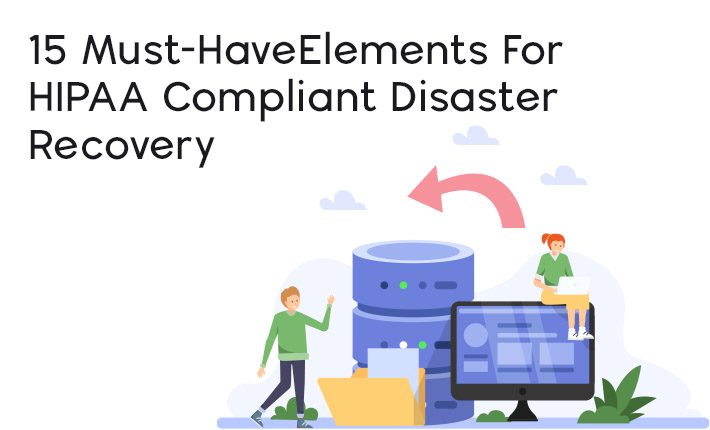In today's digital era, healthcare organizations face numerous challenges in safeguarding patient data while maintaining uninterrupted operations during disasters. Compliance with the Health Insurance Portability and Accountability Act (HIPAA) is crucial to protect sensitive information and ensure business continuity. This article explores the 15 essential elements that healthcare entities must consider when implementing a HIPAA compliant disaster recovery plan.
Comprehensive Risk Assessment
Before developing a disaster recovery strategy, healthcare organizations must conduct a thorough risk assessment. This process involves identifying potential threats and vulnerabilities to patient data, IT recovery, infrastructure, and operations. By understanding these risks, organizations can tailor their disaster recovery plans to address specific vulnerabilities effectively.
Robust Data Backup and Recovery Solutions
A HIPAA compliant disaster recovery plan requires a reliable and secure data backup system. Regular backups ensure that patient records and critical data are protected and can be quickly restored in the event of a disaster. Backup solutions should incorporate encryption and offsite storage to ensure data integrity and accessibility.
Redundant IT Infrastructure
To maintain business continuity, healthcare organizations should have redundant IT infrastructure in place. This includes backup servers, power supply systems, and network connectivity. Redundancy ensures that even if one component fails during a disaster, operations can continue seamlessly with minimal downtime. Understanding how to repair power supplies can be valuable in such scenarios. Learn more on how to repair power supplies here.
Contingency Communication Plan
Effective communication is crucial during a disaster. A HIPAA compliant disaster recovery plan should include a contingency communication strategy that enables clear and timely communication among staff, patients, and external stakeholders. This may involve alternative communication channels, such as secure messaging platforms or designated communication protocols.
Emergency Response Team and Training
Having a dedicated emergency response team is vital for executing the disaster recovery plan effectively. The team should consist of individuals with defined roles and responsibilities. Regular training and simulations should be conducted to ensure that team members are well-prepared to respond promptly and efficiently during a crisis.
Incident Response Plan
In addition to a disaster recovery plan, healthcare organizations must have an incident response plan. This plan outlines the immediate actions to be taken when a security breach or data loss occurs. It includes steps to contain the incident, notify relevant parties, investigate the cause, and implement corrective measures. Adhering to HIPAA breach notification requirements is critical during this phase.
Testing and Exercising
Regular testing and exercising of the disaster recovery plan are essential to identify potential weaknesses and validate its effectiveness. Through simulations and drills, organizations can assess their readiness to handle different types of disasters and make necessary improvements. This process helps refine the plan, train staff, and increase overall preparedness.
Compliance Audits and Documentation
Maintaining compliance with HIPAA regulations requires regular audits and documentation. Organizations must periodically assess their disaster recovery plans to ensure they align with current regulations and industry best practices. Detailed documentation of the plan, testing results, incident response procedures, and staff training is crucial for demonstrating compliance during audits.
Business Associate Agreements (BAAs)
Healthcare entities often collaborate with external vendors and business associates who handle patient data. To ensure HIPAA compliance, organizations must establish Business Associate Agreements (BAAs) that outline the responsibilities and requirements for safeguarding patient data during disaster recovery efforts. BAAs should include provisions for data protection, confidentiality, and breach notification.
Continuous Improvement and Adaptability
Disaster recovery plans should not remain stagnant. Healthcare organizations must continuously evaluate their plans, identify areas for improvement, and adapt to emerging threats and technological advancements. Regular reassessment, updating, and staff education are essential to maintain a robust and up-to-date disaster recovery strategy.
Data Encryption and Access Controls
HIPAA mandates that patient data be protected through encryption and strict access controls. A HIPAA compliant disaster recovery plan should include encryption protocols for data both at rest and in transit. Access controls, such as strong user authentication and role-based permissions, ensure that only authorized personnel can access sensitive information during disaster recovery operations.
Business Impact Analysis
Conducting a thorough business impact analysis (BIA) is crucial for prioritizing critical systems, processes, and functions during a disaster. The BIA helps identify the potential financial, operational, and reputational impacts of disruptions, enabling healthcare organizations to allocate resources effectively and ensure the continuity of essential services.
Documentation Retention and Accessibility
Healthcare entities must adhere to specific document retention and accessibility requirements outlined in HIPAA. A disaster recovery plan should address these requirements by including protocols for securely storing and retrieving important documentation, such as patient records, contracts, and compliance documentation. Consideration should be given to offsite storage or cloud-based solutions for enhanced accessibility and resilience.
Vendor Management and Service Level Agreements (SLAs)
When engaging third-party vendors for disaster recovery services, healthcare organizations should establish clear service level agreements (SLAs) that outline expectations, responsibilities, and performance metrics. Regular vendor assessments should be conducted to ensure compliance with HIPAA regulations and the ability to meet recovery time objectives (RTOs) and recovery point objectives (RPOs).
Continuous Monitoring and Incident Response Testing
Maintaining the security and effectiveness of a HIPAA compliant disaster recovery plan requires continuous monitoring and incident response testing. Healthcare organizations should implement robust monitoring tools and processes to detect and respond to potential security breaches or disruptions promptly. Regular incident response drills and exercises help validate the effectiveness of the plan and identify areas for improvement.
Conclusion
By incorporating these 15 elements into a HIPAA compliant disaster recovery plan, healthcare organizations can enhance their ability to safeguard patient data, ensure business continuity, and meet regulatory requirements. Adhering to best practices and regularly reviewing and updating the plan will help organizations stay prepared for potential disasters and minimize the impact on operations and patient care.

















Post Comments